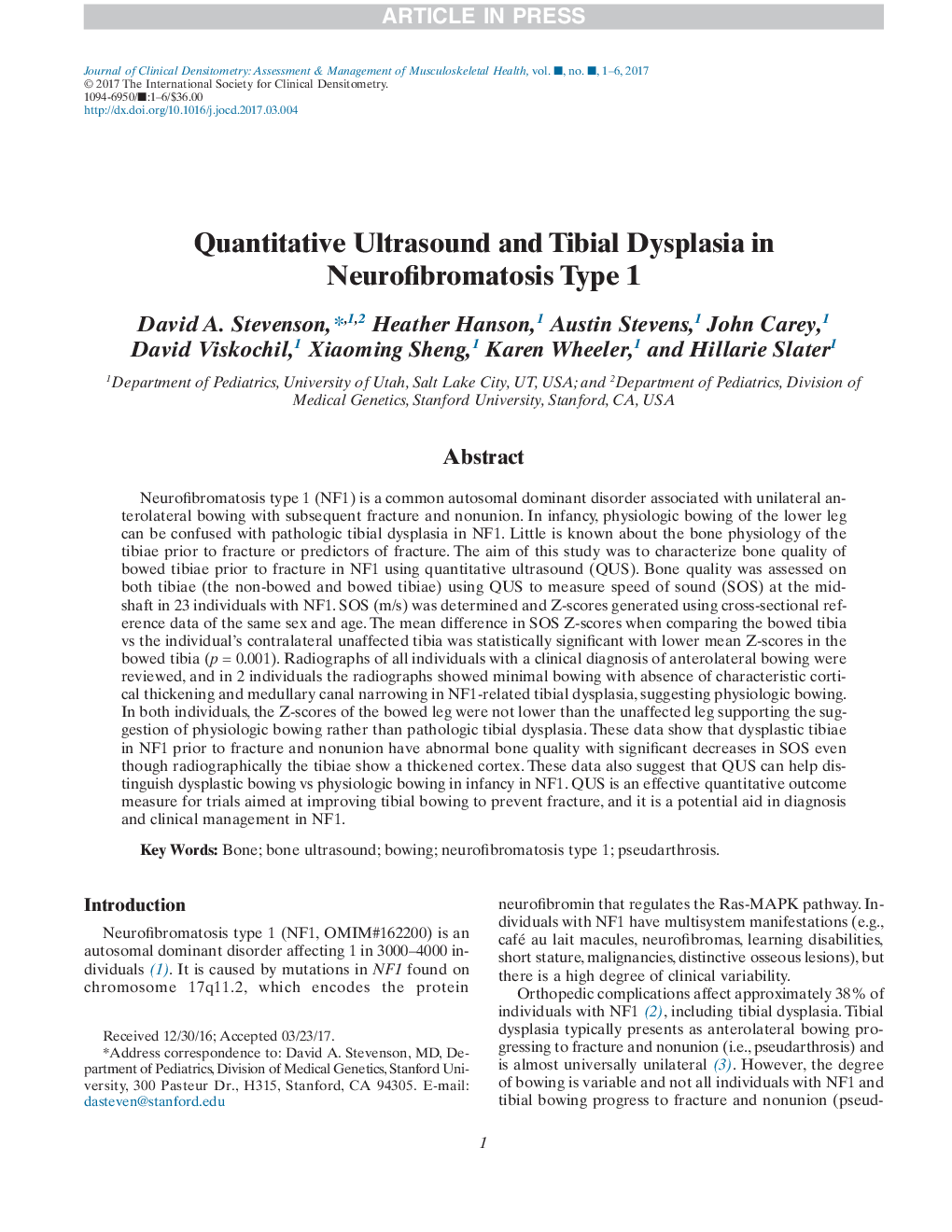| کد مقاله | کد نشریه | سال انتشار | مقاله انگلیسی | نسخه تمام متن |
|---|---|---|---|---|
| 8722914 | 1589612 | 2018 | 6 صفحه PDF | دانلود رایگان |
عنوان انگلیسی مقاله ISI
Quantitative Ultrasound and Tibial Dysplasia in Neurofibromatosis Type 1
ترجمه فارسی عنوان
تنگی نفس و تنگی نفس در نوروفیبروماتوز نوع 1
دانلود مقاله + سفارش ترجمه
دانلود مقاله ISI انگلیسی
رایگان برای ایرانیان
کلمات کلیدی
موضوعات مرتبط
علوم پزشکی و سلامت
پزشکی و دندانپزشکی
غدد درون ریز، دیابت و متابولیسم
چکیده انگلیسی
Neurofibromatosis type 1 (NF1) is a common autosomal dominant disorder associated with unilateral anterolateral bowing with subsequent fracture and nonunion. In infancy, physiologic bowing of the lower leg can be confused with pathologic tibial dysplasia in NF1. Little is known about the bone physiology of the tibiae prior to fracture or predictors of fracture. The aim of this study was to characterize bone quality of bowed tibiae prior to fracture in NF1 using quantitative ultrasound (QUS). Bone quality was assessed on both tibiae (the non-bowed and bowed tibiae) using QUS to measure speed of sound (SOS) at the mid-shaft in 23 individuals with NF1. SOS (m/s) was determined and Z-scores generated using cross-sectional reference data of the same sex and age. The mean difference in SOS Z-scores when comparing the bowed tibia vs the individual's contralateral unaffected tibia was statistically significant with lower mean Z-scores in the bowed tibia (pâ=â0.001). Radiographs of all individuals with a clinical diagnosis of anterolateral bowing were reviewed, and in 2 individuals the radiographs showed minimal bowing with absence of characteristic cortical thickening and medullary canal narrowing in NF1-related tibial dysplasia, suggesting physiologic bowing. In both individuals, the Z-scores of the bowed leg were not lower than the unaffected leg supporting the suggestion of physiologic bowing rather than pathologic tibial dysplasia. These data show that dysplastic tibiae in NF1 prior to fracture and nonunion have abnormal bone quality with significant decreases in SOS even though radiographically the tibiae show a thickened cortex. These data also suggest that QUS can help distinguish dysplastic bowing vs physiologic bowing in infancy in NF1. QUS is an effective quantitative outcome measure for trials aimed at improving tibial bowing to prevent fracture, and it is a potential aid in diagnosis and clinical management in NF1.
ناشر
Database: Elsevier - ScienceDirect (ساینس دایرکت)
Journal: Journal of Clinical Densitometry - Volume 21, Issue 2, AprilâJune 2018, Pages 179-184
Journal: Journal of Clinical Densitometry - Volume 21, Issue 2, AprilâJune 2018, Pages 179-184
نویسندگان
David A. Stevenson, Heather Hanson, Austin Stevens, John Carey, David Viskochil, Xiaoming Sheng, Karen Wheeler, Hillarie Slater,
